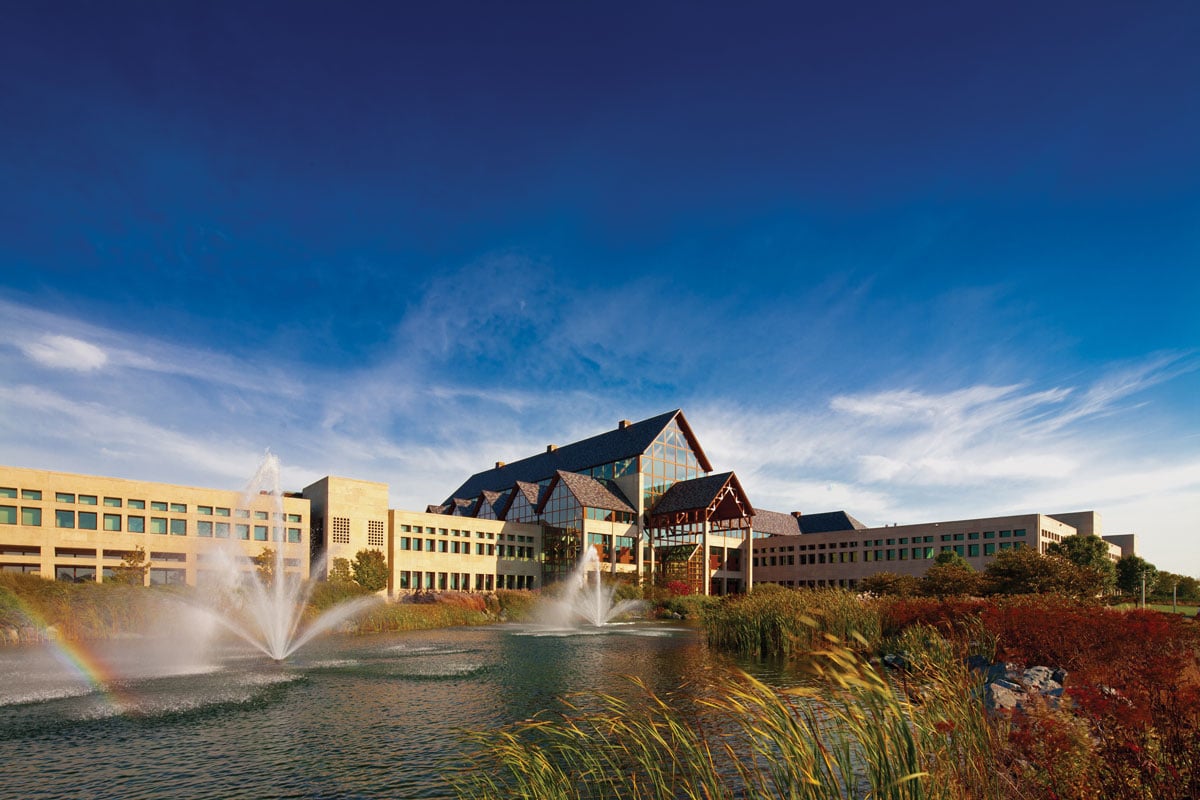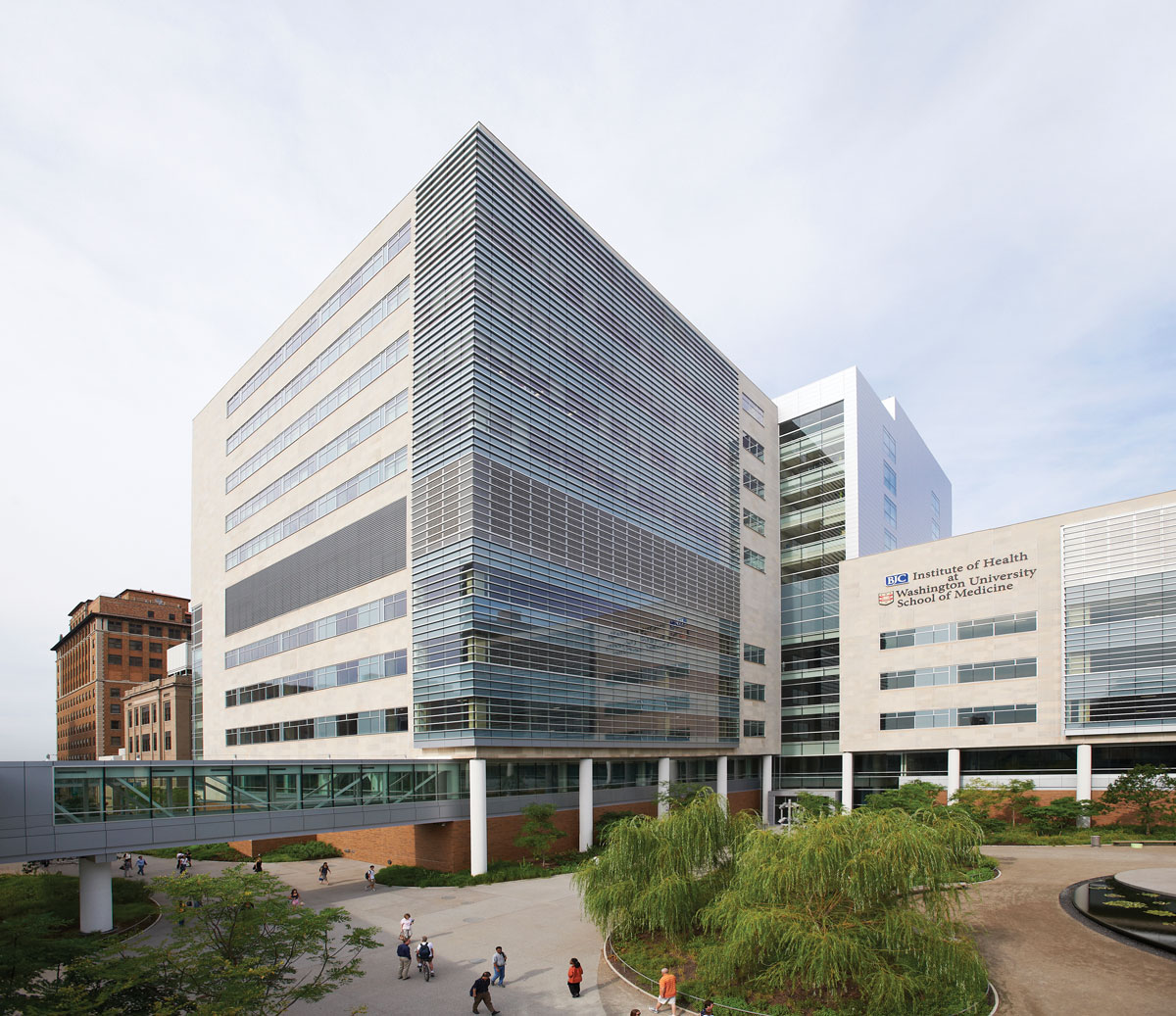
Architects used 55,000 square feet of Biesanz MDL with Natural Stone Panels for the exterior of the Acuity Insurance Headquarters in Wisconsin. Architects used 55,000 square feet of Biesanz MDL with Natural Stone Panels for the exterior of the Acuity Insurance Headquarters in Wisconsin. Architects used 55,000 square feet of Biesanz MDL with Natural Stone Panels for the exterior of the Acuity Insurance Headquarters in Wisconsin. Photo courtesy of Biesanz Stone
When looking for a truly distinctive appearance inside or out, prefabricated natural stone panels help designers achieve that special vision. It’s that made-from-nature uniqueness that drew Darrell Stahlecker, president of Biesanz Stone, to move from the concrete business to natural stone. “I decided that instead of trying to create the perfect stone I would do one better and use what I was trying to create,” he says. Stahlecker (along with an investor group) purchased the century-old, Minnesota-based company in 2010.
A stone masonry supply company to start, the Biesanz family began producing panelized stone in the late 1970s. Since then the company has evolved into a comprehensive, technical production system. Biesanz’s mission is to enable customers to use the natural, low-energy product at a competitive price using prefabricated natural stone panels to enhance a building’s facade or add flair to an interior. The pre-fabricated panels are built under optimal conditions, are ready for install when the supporting structure is complete, and have a host of other benefits.
They’re lightweight
Biesanz’s panels are approximately one-third of the weight of a precast concrete panel with the steel studs attached. It’s a complete wall system, unlike precast panels, which require the addition of a stud wall. Natural stone panels are thinner, approximately two inches, whereas precast panels are six to eight inches. “They require a lot less structural members, structural steel, or concrete to support the structure because they are so lightweight on the project,” says Todd Shaffer, head of drafting/design at Biesanz Stone. The lower weight of the panels also enables them to be easily lifted by a forklift or crane.
They’re easy to install
Installation is fast and easy. Each panel is designed specifically for the structure. Shaffer works with the architect’s design to determine the prefabricated panels’ dimensions and where anchors need
to be placed. “Everything is predesigned to meet the structural members,” Stahlecker says. Connections are designed to go floor heights. Install rates are in accordance with design.
Natural stone panels can cover more square footage in fewer panels, too. One large panel is approximately 8-by-14 feet. Approximately 700 to 1,000 square feet of natural stone panels can be installed
in one day. Installation is less likely to be impacted by weather. And panels can still be set in weather that is 10 below zero, unlike typical masonry, which requires additional tenting and heating in colder temperatures, Stahlecker says.
They’re high design
Designers have many options when using natural stone panels. They can choose to use Biesanz’s Minnesota Dolomite Limestone or go with another stone of their choice. “We build and design the panels in accordance with the architect’s and customer’s vision. If they choose Indiana Limestone, we purchase Indiana Limestone,” Stahlecker says. Company logos or other designs can easily be etched into the panel before installation, too. Biesanz offers nine options for stone finishes that can be customized to meet any design vision. The finish will stay on for the duration of the stone’s life.
They’re cost-effective
Stone comes from the ground, reducing production costs. “We don’t have the cost associated with creating the product, and we aren’t using the substantial amounts of energy it takes to create cement-based products, much less to cut it to size and shape it,” Stahlecker says. “It’s a stand-alone resource.”
Biesanz’s team works with customers to make the project as affordable as they can. “We take the architect’s plan and design our panels like a puzzle, determining how they can best fit on the building in an economical manner,” Shaffer says.

The BJC Institute of Health at Washington University School of Medicine has more than 90,000 square feet of Biesanz Natural Stone Panels with stone from Indiana Limestone Company. Photo courtesy of Biesanz Stone.
They last
Of course, stone is also a product that has stood the test of time. “We have a lot of projects that have been in existence since the 1980s, and we’ve had virtually no warranty work to do. The panels don’t shrink or expand like other products,” Stahlecker says. Concrete precast panels will absorb water over the years, placing stress on the panels over time. “Our stone won’t change in a 50- to 100-year building, but concrete and other manufactured products may not last that long.”
They’re made in a one-stop shop
Biesanz Stone is a single-source for engineering, design, fabricating, furnishing, and installing natural stone panels, speeding up the overall process. “We function as the subcontractor, overseeing and handling the install all under one umbrella,” Stahlecker says.
The company warranties the complete system once it is in place. Being a one-stop shop allows the company to ensure installation is done at a high quality, meeting top industry standards.

